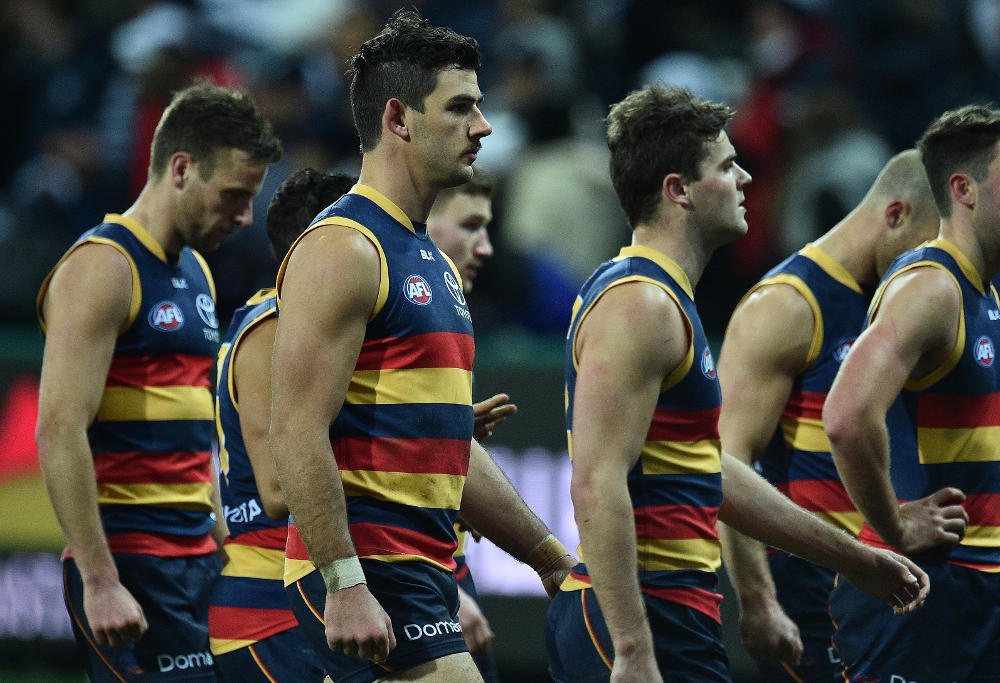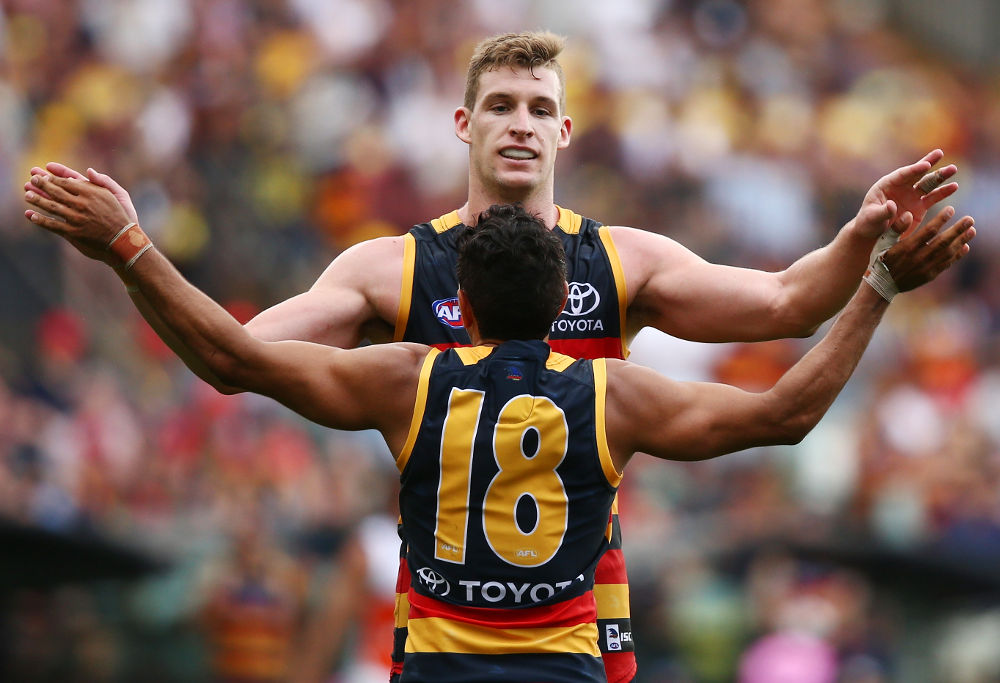'Needs to be something': Tex backs 'captain's call' after AFL admitted Crows were dudded... again
Adelaide's Taylor Walker has thrown his support behind a 'captain's call' in order to prevent umpiring blunders, which the Crows have been on the…

From the Editors: The Richmond Tigers won the AFL Grand Final yesterday, in a result that has made yellow and black fans very happy. But what if they hadn’t?
The Roar asked Ryan Buckland to put together two columns ready to go for the grand final finish – one for either result. Only one would be published – the other, you were never meant to see.
But we figured, why waste Ryan’s good work? For those who’d like to stroll down alternate-reality lane, below you can find – unedited – the words we would have published if the Crows lifted the cup.
Enjoy!
All the wash-up from the 2017 AFL Grand Final
» Match Report: Tigers are premiers
» BUCKLAND: Richmond go from rabble to flag
» Six talking points from the match
» Richmond Tigers player ratings
» Adelaide Crows player ratings
» Watch video highlights from the match
» Re-live the match with our live blog
The Adelaide Crows have made good on an incredibly long, arduous and winding road to a premiership, and in the process have perhaps ushered in a new way of thinking about modern football.
That’s a grandiose statement, and we will get to it shortly. First, the story you already know. As far as football clubs go, Adelaide has hit just about every speed bump imaginable in the past five or so years.
A salary cap rorting scandal, constant poaching of quality players, a bad stadium deal, the departure of their best player – everything in a football sense bar a board challenge.
There is also the unfathomable passing of their 2015 head coach Phil Walsh in the most tragic of circumstances – a moment which transcended a professional recreation activity and struck a chord across the country.
It had material ramifications for the Crows too; the sadness and grief would have taken the football club to a place it would have never thought possible.
Adelaide overcame it all, as a united club, and have won this year’s premiership. That’s not to underplay the adversity – it’s just you are already an expert on the matter.
Instead, we should revel in what the Crows have achieved on the field, and what it might mean for the league going forward.
Adelaide were supposed to be too thin through the middle of the ground to make much noise this year. Their failure to secure Bryce Gibbs from Carlton in the last offseason was a concrete ceiling on their ambition.
The Crouch Brothers could improve, but Scott Thompson was getting older. Could Rory Sloane be a team-shaping superstar? Is Richard Douglas really part of a premiership contending midfield?

(AAP Image/Julian Smith)
Genuine questions, all of them. The Crows were well set at either end of the ground. A defence built on a fleet of iron fists in the air and unassuming ground ball warriors, an efficiently structured, well-drilled attack populated with outstanding ball users.
But what’s the good of all that if the midfield gives up too many looks, or doesn’t generate enough looks? Adelaide ended up with the league’s second-best inside 50 differential on the year, +8.4 per game, building on last year’s tidy results.
Critically – and this is where the grandiose statement justification begins don’t worry – Adelaide recorded an inside 50 differential of +13.3 per game against teams that finished with them in the top eight.
In second was today’s vanquish, the Tigers, on +3.4 per game. The Crows didn’t just win a ton of territory, and created opportunities for their efficient forward line: they did it against the best teams, and did it better.
How? It came back to Adelaide’s midfield, and the unique structure coach Don Pyke and his coaching staff have built. The weakness we all presumed exist turned out to be a hidden strength.
Adelaide employs a core group of inside midfielders, who do the majority of the inside work. The Crouch Brothers, Matt and Brad, and Rory Sloane are the Crows’ group at almost every stoppage. Around them are a fleet of mid sized, fleet footed or agile, rangey flankers, who receive the ball and move it to advantage.
Rory Laird is the avatar; the list of players is long, but the names don’t really matter. What does matter is the unit is so well drilled, and so skilled on average, that the Crows have turned a perceived weakness into a bonafide strength.
Where the rest of the competition rotates their midfielders through the inside, the Crows roll them on the outside.
Layer on to that the team’s penchant for a spare aerial defender – generally Jake Lever – and the precision engineered forward line. The Crows are a well drilled, well organised, efficient football team in every sense.
It is any wonder they emerged as the best team in the league in the first round of the season, and never really gave up the advantage thereafter?
It could have been quite different. Under Walsh, Adelaide’s mantra was groundballs, groundballs and more groundballs. Walsh famously made his team jump into the freezing cold Brighton beach waters when they took a bath on the in-vogue metric.
The Crows were building to be a different version of last year’s Bulldogs, and this year’s Tigers: a meat grinder. The difference came in Adelaide’s finely tuned forward line.
That hasn’t really changed. Adelaide’s forward line off outcasts, misfits and bolt-on additions has fallen into place, piece by piece, since the Crows took Taylor Walker as an underage prospect in 2007.
In 2011 Tom Lynch came from the Saints, and Josh Jenkins from the Bombers. Eddie Betts joined in 2013 as an “overpaid” free agent, and Charlie Cameron was picked up in the rookie draft.

(Photo by Morne de Klerk/Getty Images)
The finishing piece, Mitch McGovern, who sadly missed the win, was drafted in the third round in 2014.
Football is supposed to be pulling teams in the opposite direction to where the Crows have taken their forward line.
Four tall players, albeit one who plays as high as any forward has played in recent years, is the antithesis of the small ball movement taking hold across the league.
It is doubtlessly helped by the gravitational play of Betts, whose touch with ball in hand – or close to hand – is verging on otherworldly.
Adelaide showed the competition that structure needn’t be all about defence, about stopping joyous football from happening.
With the style of its success, one can’t help but think of the words of the late Walsh after the famed Patrick Dangerfield vs Nat Fyfe game of Round 9, 2015.
“When I went to the footy as a young guy from Hamilton, and it wasn’t that often we’d go down (to the city), but we’d watch great player versus great player and that’s what we saw tonight.”
“Maybe, I’m a weirdo! I want to win … I know we’ve got to win enough games to get into finals and that’s paramount, but I also think we have to protect the game.”
The context is a little different, but the sentiment is there all the same. The Adelaide Crows showed us this year there is a better way to play the game, bullied their way across the competition, and ended the season with a win in the last game of the year.
Even if that win hadn’t materialised, that the Crows have achieved what they have is a testament to what AFL football can, and I think should, be.
The AFL is a me-too league. We can only hope the code’s 17 other coaches take heed of what they saw Adelaide accomplish in 2017, and keep the words of the resilient club’s fallen mentor front of mind as they plot and scheme to win it all. They will have a mean task of taking the crown from these Crows.